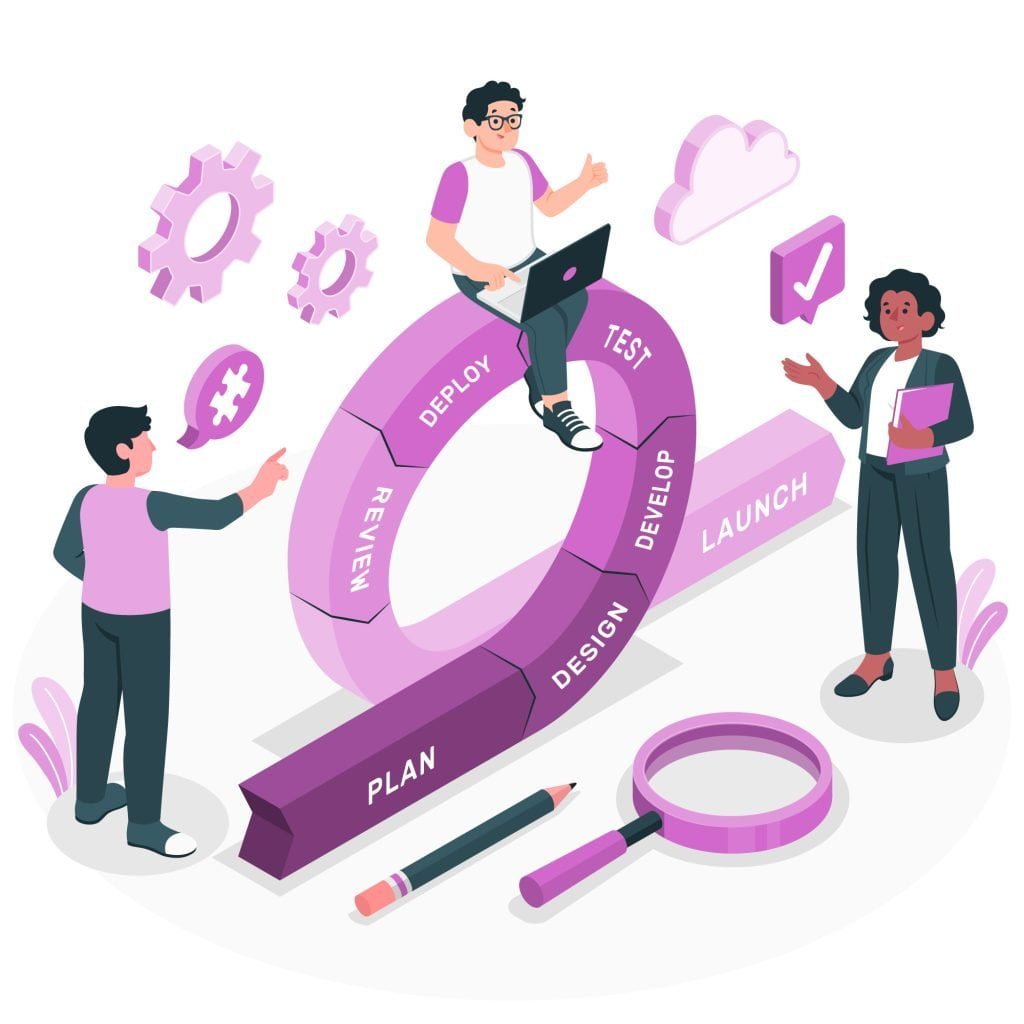What is Agile Leadership?
Agile leadership represents a management approach focused on flexibility, teamwork, and ongoing enhancement. Inspired by Agile practices originally developed for software creation, this leadership style extends those concepts across the entire organization. Below are the primary elements:
Empowering Teams through Agile Leadership
Agile leadership is characterized by a deep trust in and empowerment of teams. Agile leaders set clear objectives and boundaries, yet they grant teams the autonomy to decide on the execution strategies. This approach cultivates a culture of ownership, accountability, and heightened motivation among team members, hallmarks of effective agile leadership.
Agile Leadership’s Focus on Value
At the heart of agile leadership is the prioritization of delivering significant outcomes. Agile leaders collaborate closely with their teams to pinpoint tasks of the highest value, directing collective efforts towards achieving milestones that genuinely resonate with customers. This strategic focus ensures that the team remains dedicated to initiatives with the utmost potential for positive impact, a key principle of agile leadership.
Embracing Change in Agile Leadership
In the ever-shifting terrain of the business world, agile leadership stands out for its proactive approach to change. Agile leaders possess a keen awareness of the dynamic nature of business and prepare their teams to adeptly manage the uncertainties that come with it. They not only communicate upcoming changes with clarity and precision but also address any concerns with foresight, ensuring the team feels supported. By cultivating an environment that views change not as a challenge but as a valuable chance for learning and advancement, agile leaders foster a culture of continuous improvement and resilience. This strategic embrace of change empowers teams to innovate and thrive amidst the complexities of the modern business landscape.

12 Agile Principles
The 12 Agile Principles serve as the core of the Agile Manifesto, outlining essential guidelines for software development focused on teamwork, adaptability, and ongoing enhancement. These 12 principles are key to understanding and implementing the agile methodology effectively, emphasizing the importance of working collaboratively, being open to changes, and constantly seeking ways to improve.
- Customer Satisfaction Through Early Delivery
Agile methodologies stress the importance of quickly delivering valuable features to customers, enabling frequent feedback loops for continuous product improvement. - Welcome Changing Requirements
Agile is uniquely designed to welcome changes in requirements, even during late stages of development, facilitating adaptation to new insights and seizing fresh opportunities. - Frequent Delivery of Working Software
By regularly releasing functional software, Agile methods allow for swift feedback acquisition, significantly diminishing the likelihood of deviating from product objectives. - Collaboration Between Business and Developers
Agile underscores the necessity of a symbiotic relationship between business stakeholders and development teams, ensuring a unified direction and cohesive effort towards achieving project milestones. - Empowering Motivated Individuals
Agile places high value on the motivation of individual team members, creating a culture of trust where each member is empowered to produce quality work. - Face-to-Face Communication
Agile champions the efficacy of face-to-face interactions, regarded as the most direct and productive means of collaboration among team members. - Working Software is the Primary Measure
In Agile practices, the primary metric for assessing project success is the tangible output of working software, rather than reliance on extensive documentation or speculative planning. - Sustainable Development Pace
Agile encourages a steady, manageable pace of development, preventing burnout and ensuring long-term project sustainability. - Continuous Attention to Excellence
Agile commits to the perpetual enhancement of technical skills and design standards, essential for the delivery of superior software quality. - Simplicity is Essential
Agile methodologies advocate for concentrating efforts solely on essential tasks, simplifying processes to eliminate unnecessary complexities. - Self-Organizing Teams
Agile recognizes the strength of self-organizing teams, granting them the independence to make informed decisions and effectively manage their workload without external interference.

- Adapting to Change
Agile positions change as a critical component for organizational growth, encouraging teams to continually reassess and refine their strategies for increased efficacy.
These principles collectively form the Agile manifesto’s foundation, guiding teams and organizations toward more dynamic, responsive, and customer-centric development practices.
What Makes Agile Leadership Essential?
In today’s business environment, characterized by its rapid pace and constant evolution, traditional leadership methods often fall short in keeping up with the need for change. Agile leadership steps in as the beacon of adaptability, emphasizing the importance of flexibility, teamwork, and empowering individuals. But why is agile leadership becoming increasingly vital in navigating the complexities of the modern workplace? Let’s delve into the core reasons that underscore the indispensability of agile leadership in today’s fast-moving business world:
Fostering a Culture of Innovation Through Agile Leadership
Agile leadership is instrumental in creating an environment that champions experimentation and innovation at its core. By empowering teams to explore new ideas and take calculated risks, this
leadership approach opens the door to groundbreaking advancements in products, services, and solutions. Under agile leadership, the fear of failure is replaced with a curiosity for discovery, encouraging teams to push boundaries and innovate beyond conventional limits. This not only propels the development of novel offerings but also cultivates a dynamic workplace where creativity thrives, setting the stage for continuous improvement and a competitive edge.
Optimizing Organizational Efficiency with Agile Practices
Agile leadership is at the forefront of enhancing organizational efficiency by prioritizing the elimination of waste and the optimization of processes. Agile leaders play a pivotal role in pinpointing and dismantling obstacles that hinder productivity, thereby paving the way for smoother, more efficient workflows. This targeted approach not only accelerates project timelines but also boosts overall productivity, ensuring that resources are utilized effectively and that teams can achieve more in less time. By embedding agile practices into the fabric of the organization, agile leaders drive a culture of continuous improvement, where operational excellence becomes a defining trait of the organizational identity.
Elevating Employee Engagement Through Agile Leadership
Agile leadership significantly enhances employee engagement by empowering team members and
granting them ownership of their tasks. This empowerment fosters a sense of responsibility and investment in the work, leading to a workforce that is not only more engaged but also highly motivated. When employees feel valued and trusted by their leaders, it cultivates a positive work environment where individuals are encouraged to contribute their best. The result is a vibrant, dynamic team culture where everyone feels a strong connection to their work and the organization’s goals, driven by the supportive and trust-based approach characteristic of agile leadership.
Accelerating Market Readiness with Agile Methodologies
Agile methodologies streamline project execution by dividing tasks into shorter, manageable iterations,
significantly reducing the development cycle. This approach enables teams to swiftly deliver features and enhancements, swiftly bringing value to customers. By adopting such a strategy, organizations not only meet customer needs more promptly but also secure a formidable competitive advantage in the marketplace. This expedited time to market ensures that businesses can respond to changing market demands and opportunities with agility, positioning them as leaders in innovation and customer satisfaction.
Boosting Customer Satisfaction through Agile Leadership
Agile leadership places a strong emphasis on aligning with customer expectations and integrating stakeholders into the development process. This collaborative approach fosters a deeper comprehension of customer requirements, enabling organizations to tailor their offerings more precisely. By focusing on delivering value that resonates directly with customer needs, agile-led organizations enhance their ability to provide superior satisfaction. The proactive engagement and responsiveness to feedback characteristic of agile leadership ensure that customers feel heard and valued, further solidifying their loyalty and satisfaction with the organization’s products and services.

When Is Agile Leadership Essential?
While traditional leadership methods have their merits, they often fall short in today’s fast-evolving business environment, highlighting the need for a more adaptive approach. Agile leadership, with its emphasis on flexibility, collaboration, and empowerment, offers a compelling alternative in these fast-paced times. It’s crucial to recognize when agile leadership is the most suitable approach, as it can significantly enhance an organization’s ability to navigate change, drive innovation, and achieve success in a complex and uncertain marketplace.
Navigating Rapid Change
In an era where technological advancements, fluctuating consumer expectations, and an ever-changing competitive landscape redefine the contours of business, agile leadership emerges as a critical navigator. This leadership approach empowers organizations to swiftly adapt, ensuring they not only stay relevant
but also thrive. By embracing agile leadership, companies gain the agility required to respond to market shifts, harness new opportunities, and maintain a competitive edge in a world where change is the only constant.
Navigating an Uncertain Future
In today’s complex and rapidly evolving world, forecasting the future poses unprecedented challenges. Agile leadership is instrumental in preparing teams to maneuver through this uncertainty with confidence. By prioritizing data-driven decision-making and leveraging real-time feedback and outcomes, agile
leaders ensure that teams are not only equipped to handle the unpredictable but also poised to capitalize on opportunities as they arise. This forward-thinking approach fosters a dynamic environment where adaptability and resilience are at the forefront, enabling organizations to thrive despite the unknowns that lie ahead.

Thriving Amidst Increased Competition
In today’s market, competition across various industries has reached new heights of intensity. Agile leadership plays a pivotal role in enabling organizations to not just keep pace, but to excel and lead the pack. By cultivating an environment that champions innovation and streamlines processes, agile leadership ensures that businesses can deliver exceptional value to their customers more rapidly and efficiently. This approach not only positions companies to outmaneuver competitors but also to set new standards and expectations within their respective fields, securing a significant advantage in the race for market leadership.
Leveraging a Globalized Workforce
In an era where many organizations operate with a workforce spread across the globe, agile leadership becomes crucial in harnessing the full potential of such diversity. This leadership style excels in promoting seamless collaboration among teams scattered over various locations, transcending geographical
and physical barriers. By implementing agile principles, leaders foster a culture of inclusivity, open communication, and shared goals, ensuring that every team member, irrespective of their location, is aligned and contributing effectively. Agile leadership thus enables organizations to leverage their global workforce as a unified, dynamic force driving innovation and success.
Navigating Project Complexity
In today’s fast-paced environment, projects are evolving into intricate endeavors with multiple layers of complexity. Agile leadership plays a vital role in deconstructing these multifaceted projects into smaller, more manageable segments. This methodological approach enables enhanced planning,
execution, and monitoring at every stage of the project. Through the agile leadership lens, teams can tackle each component with clarity and precision, ensuring that even the most complex projects are delivered successfully. This not only improves overall project management but also increases the team’s ability to adapt and respond to unforeseen challenges, driving projects to fruition with greater efficiency and effectiveness.
As a conclusion, agile principles, emphasizing adaptability, collaboration, and continuous improvement, are ideal for today’s fast-evolving business environment. Agile leadership focuses on empowering teams, fostering ownership, and ensuring accountability, which enhances team motivation and outcomes. It prioritizes impactful results and customer-centric approaches, treating change as an opportunity for growth.
Moreover, it champions open communication and collaboration, essential for transparency and effective decision-making. Continuous learning underpins the agile approach, keeping organizations innovative. In summary, Agile leadership equips organizations to be efficient and responsive, paving the way for long-term success in a dynamic business landscape.
Explore our training on Agile & Scrum here.





